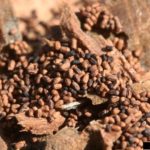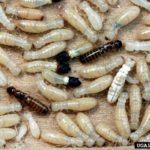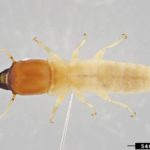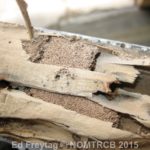General Information
Drywood termites are important pests of structures throughout the country, though the more destructive Incisitermes species are restricted to certain warmer southern states and humid coastal areas. They feed on dry, sound (nondecayed) wood and are more commonly reported from older structures. They can infest wood flooring, framing members, windowsills, doors, fascia boards, and furniture. They are also known to infest attics where the external temperature of the wooden members can exceed 110 degrees F. Drywood termite colonies are rather small (a few thousand individuals), and colonies develop relatively slowly. They neither live in the ground nor maintain contact with the soil, and they do not build mud tubes.

western drywood termite pellets
Drywood termite damage is distinct from other termite damage. Galleries are smooth sided and free of the mud spots typical of subterranean termites. Drywood termite galleries cut across both the light (spring) and dark (summer growth) wood rings, compared to subterranean termites, which feed primarily in the light growth rings and the galleries go along the grain. The most definitive sign of drywood termite damage is the presence of numerous, tiny six-sided pellets (see picture). Pellets may be seen falling from infested wood trim, furniture, or wood studs.
Identification
Drywood termites can be identified either by the insects themselves or by their unique signs.
- Immature stages are wingless, white to beige in color, 1/4- to 3/8-inch (6 -10 mm) long and make up the largest number of individuals within a colony.
- It’s difficult to distinguish drywood termites from other termites based on samples of immatures alone. However, drywood termites may be distinguished from subterranean termites by comparing:
- the width of the first segment behind the head (pronotum) to the width of the head. The first segment behind the head of drywood termites is as wide or wider than the head while, the first segment behind the head of subterranean termites is narrower than the head.
- Effort should be made to collect either soldiers or winged forms to confirm a drywood termite problem.
- Soldiers resemble the immature form in color and general appearance; however, they have large, brownish to yellowish-brown heads.
- Have enlarged, heavily sclerotized mandibles (jaws), the shape and form of which can be used to identify the species. The most commonly encountered form of drywood termite is the alate (winged reproductive).
- During swarming season, alates will leave the nest and may be noticed by building inhabitants, typically dusk and dawn.
- Alates vary in color from dark brown to light, yellowish tan. Wings may be almost clear to smoke gray and have three major veins in the leading edge of the forewings. Alates typically drop their wings quickly after exiting the nest.
Three of the most common drywood termites in the United States include the following:
 west indian powderpost drywood termite |
The West Indian drywood termite (Cryptotermes brevis) soldier is easy to identify by its distinctive phragmotic head, which resembles a burnt match and is used to block the tunnels to protect the colony from intruders, especially ants. This termite typically infests picture frames, furniture, boxes, and structural woodwork. Interestingly, this species is never found in natural environments but only in wood in human-made structures. Depending on location, this termite usually swarms from April to early July and November to early December. |
 This is one of two major drywood termites in the United States. |
Southeastern drywood termite (Incisitermes species) colonies are generally larger than those of the West Indian drywood termite and cause more serious structural damage. These termites are found in both natural and human-made environments and are the most common drywood termites in Florida. Development of the colony is slow, but structural damage can be extensive if multiple colonies are present in the same structure. This termite usually swarms from May through November in most locations. |
 Western drywood termites with fecal pellets were found infesting sofa |
The western drywood termite (Incisitermes minor), is a nonnative termite and the number one drywood termite pest in the western United States. Depending on location, it usually swarms from the end of August through November. Western drywood termite soldiers are recognized by the enlarged, club-like third antennal segment that is as long or longer than the fourth through sixth antennal segments combined. These termite alates are dark brown with smoky-black wings and a ½-inch long body. Colonies may be over 2 years old before there evidence is seen. |
Suggested Thresholds
Finding multiple drywood termite wings inside a building or evidence of drywood termite pellets warrants further inspection and possible treatment or removal of infested wood. Finding pellets in multiple locations may indicate need for building fumigation.
Monitoring and Inspection
 When monitoring for drywood termites, look for small piles of six-sided fecal pellets. Pellets are ejected by immature termites through pencil-tip-sized kick-out holes (1-2 mm diameter) in infested material. Pellets may be multicolored and ranges from light brown to almost black depending on the color of the wood. It is gritty when rolled between the fingers, and when examined under magnification, will have six distinct sides. Wood near pellet piles should be examined for the kick hole, indicating the exact location of infested wood. A sign of advanced infestation is wood surface blistering or warping, where termites have tunneled just under the surface of the wood. Tapping wood with the handle of a screwdriver or probing with a sharp tool is helpful for detecting termite damage that is not obvious on the surface of damaged wood.
When monitoring for drywood termites, look for small piles of six-sided fecal pellets. Pellets are ejected by immature termites through pencil-tip-sized kick-out holes (1-2 mm diameter) in infested material. Pellets may be multicolored and ranges from light brown to almost black depending on the color of the wood. It is gritty when rolled between the fingers, and when examined under magnification, will have six distinct sides. Wood near pellet piles should be examined for the kick hole, indicating the exact location of infested wood. A sign of advanced infestation is wood surface blistering or warping, where termites have tunneled just under the surface of the wood. Tapping wood with the handle of a screwdriver or probing with a sharp tool is helpful for detecting termite damage that is not obvious on the surface of damaged wood.
Nonchemical Control Measures
Sanitation/Cultural Controls
- Control moisture during building construction in areas prone to this type of termite damage
Physical/Mechanical Controls
- Ensure all soffit vents, doors, and windows of wood framed buildings should be screened with 20-mesh screen.
- A good coat of paint on exposed wood will provide some protection against termite entry. Before painting, all cracks and crevices should be filled with putty or plastic wood.
- Pressure-treated wood is resistant to termite attack. Certain woods are naturally resistant to termites, including redwood heartwood, bald cypress, mahogany, and Spanish cedar; however, these woods can be more expensive and will become susceptible after several years when subjected to aging and weathering. Construction should be designed to eliminate moisture and water leaks.
- Where drywood termite infestations are isolated, wood removal and replacement may be the best option.
- Where termites are more widespread in a structure, heat treatment can be used for whole structure or compartmental treatments.
Chemical Control Measures
Spot treatment of known infestations are subject limitations due to the nature of this pest and ability to penetrate deep enough to eradicate the colony. Infested wood can be treated by injecting or placing insecticide directly into a termite gallery. Spray applications can also be made to cracks and crevices such as the spaces between wooden pieces or between different building materials, such as wood and concrete, where there is evidence of an infestation. Use a product labeled for indoor surface treatments if treating indoors, and outdoor treatment if treating termites found outdoors.
If the infestation is too extensive and advanced for spot treatment, it may be necessary to tent and fumigate the entire building. Although this method can be expensive and disruptive to school activities over several days, it is frequently the only effective option for serious infestations.
Fumigation’s must be performed only by persons who have been trained and certified specifically for fumigation. Fumigant gases are extremely toxic, but fumigation can be performed safely in school buildings by trained applicators. When proper aeration steps, as outlined on label directions, are followed, there is minimal risk of occupant chemical exposure. Because drywood termite damage occurs slowly, there should be no need to rush into a fumigation, which is best scheduled for holidays or during summer vacation. Twenty-four hours after fumigation is completed, fumigants will no longer provide protection from drywood termites.
Evaluation Methods
Drywood termites are hidden living within wood making them hard to find. These insects are usually detected when they swarm or kick out pellets, and when structures are repaired. Detecting drywood termites requires experience. Visual inspections should be made in accessible areas. Sometimes walls may need to be removed to allow inspections behind them.; Inspections should be made for pellets, shed wings, damaged wood, or kick out holes. The presence of six-sided pellets is diagnostic for drywood termites. However, the presence of these pellets does not mean that the structure is infested with active drywood termites. Active infestations would be indicated if live drywood termites are found or if more pellets appear a few days after pellets have been removed from a location. Pellets may fall from wood following vibrations of structures. Additionally, dogs, acoustic devices and odor detectors may be used to detect drywood termites.
Authors: Developed by Faith Oi, Dennis Ring, and Mike Merchant
